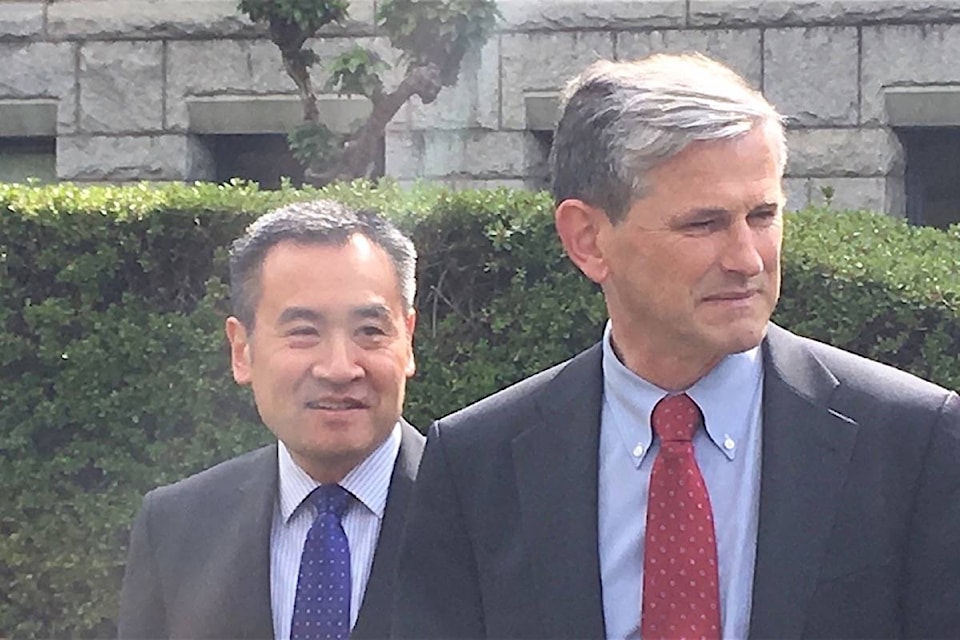Premier John Horgan isn’t ruling out a broadcast debate with B.C. Liberal leader Andrew Wilkinson on proposed changes to B.C.’s voting system, but says if it happens it would be after municipal elections on Oct. 20.
Asked about the debate challenge in Vancouver Wednesday, Horgan noted that the B.C. legislature resumes sitting next week.
“I’m not ruling out having a face-to-face debate with Mr. Wilkinson,” Horgan said. “We’ll see what happens but we want to certainly get through the municipal campaigns right now.
“That’s where people are focusing their attentions. And the discussion about making our electoral system fairer, making sure that there is less conflict and more cooperation is something that Mr. Wilkinson and I will have ample opportunity to talk about I’m sure, in the weeks ahead.”
48 hours and still no answer from John Horgan. The people of British Columbia deserve the opportunity to hear both sides of the argument. Let’s get the #PropRep facts on the table - what do you say @jjhorgan? #bcpoli pic.twitter.com/ZAyj84YB1M
— Andrew Wilkinson (@Wilkinson4BC) September 26, 2018
Wilkinson issued the challenge Monday. He said he was touring the province during the summer, and found “most British Columbians” were not even aware that a referendum is coming up. He called for a one-on-one debate with Horgan, not including B.C. Green Party leader Andrew Weaver, who made the referendum a condition of supporting the NDP minority government last year.
“As leaders of the two largest parties in the province, I believe it’s our responsibility to come together to ensure that British Columbians understand the arguments for and against altering our electoral system,” Wilkinson said. “Let’s provide voters with the information they deserve ahead of this profoundly important vote.”
Horgan used much of his speech at the recent Union of B.C. Municipalities convention to pitch changing the provincial election system to one of three forms of proportional representation.
40 per cent of the vote should not mean 100 per cent of the power. Join our campaign to support proportional representation and make your vote count. Sign up @ https://t.co/ZFMcN7WnY4 #pr4bc #prorep pic.twitter.com/bdQjeN72YC
— John Horgan (@jjhorgan) September 18, 2018
When the rules and questions for the referendum were revealed on the last day of the legislature session in May, Wilkinson called it a “sleazy and manipulative” step to avoid public debate. The referendum itself was rushed into place with an “alphabet soup” of untested options and no voter turnout threshold, he said.
Our democracy is too important for political games. We need to provide voters with the information they deserve ahead of this profoundly important vote, which is why I’m challenging Premier @jjhorgan to a public debate on the #PropRep referendum. #bcpoli pic.twitter.com/031ClfuEfD
— Andrew Wilkinson (@Wilkinson4BC) September 24, 2018
Ballots are to be mailed out in late October to all registered voters in B.C., and must be returned by the end of November.
Attorney General David Eby has decided the ballot will contain two questions, the first being a choice between the current “first past the post” system for choosing MLAs, and a proportional representation system.
The second question is a choice of three systems, determined after review of more than 90,000 submissions. They are:
• Dual member proportional, where neighbouring pairs of districts in B.C. would be combined into one two-member constituencies, except for the larger rural districts, which would remain unchanged.
• Mixed member proportional, which combines single-member districts with party list candidates, added to give each party the number of seats determined by their share of the province-wide vote in an election.
• Rural-urban proportional representation, with multi-member districts for urban and semi-urban areas, with voters choosing their MLA on a ranked ballot. In rural areas, a mixed-member proportional system using candidate lists chosen by parties would be used.
The complexity of the options means voters will not have an official map of the new voting districts when they make their choice. Eby said if voters choose to change to a new system, the district boundaries would be determined by the independent Electoral Boundaries Commission.
@tomfletcherbc
tfletcher@blackpress.ca
Like us on Facebook and follow us on Twitter.
